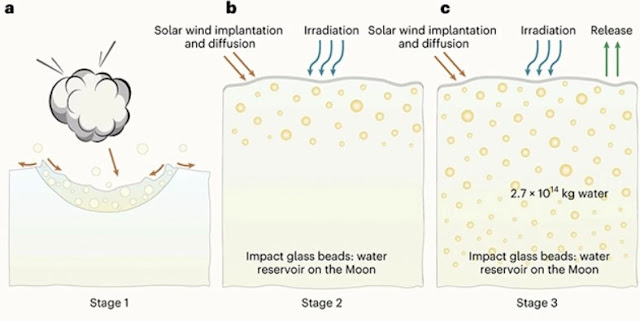Just how much water does the Moon hide? Hundreds of billions of tons
While the presence of water on the Moon is no longer a mystery, there are still lingering inquiries regarding its origins, storage mechanisms, and distribution dynamics. In a recent investigation, a team of Chinese and British scientists has pinpointed minuscule glass beads within lunar soil as potential reservoirs where water could be concealed.
The sheer magnitude of water identified is astonishing, potentially reaching a colossal 297.6 billion tons, says a study published in the journal Nature.
This fresh revelation stems from the analysis of samples collected during China's Chang'e 5 rover mission. Executed in December 2020, the spacecraft meticulously gathered lunar surface materials over a span of several weeks, yielding remarkable insights through subsequent investigations.
Microscopic glass beads typically form when cosmic fragments collide with a surface, leading to the vaporization of minerals that subsequently solidify into vitreous fragments, often measuring just tens or hundreds of micrometers across. These beads, scrutinized in earlier Apollo lunar samples, challenged prevailing assumptions regarding the Moon's aridity.
More to read:
Saturn moon squirted an enormous water vapor into space
Present studies propose that a considerable proportion of the Moon's water arises with the assistance of solar winds.
Here, hydrogen ions from solar particle showers combine with oxygen already embedded in the lunar soil.
The reservoir of water potentially harbored within these glass beads may play a crucial role in the lunar water cycle, as outlined by the researchers responsible for this recent study. As some water escapes into space, it can be replenished by the reserves contained within these amorphous impact glass formations.
The researchers note in their paper, "The impact glass beads preserve hydration signatures and display water abundance profiles consistent with the inward diffusion of solar wind-derived water."
Each glass bead can accommodate a substantial amount of water – up to 2,000 micrograms (0.002 grams) for every gram of the particle's mass. Based on the analysis of hydration signatures, the scientists posit that these beads can accumulate water over the course of just a few years.

The implications of this discovery are particularly relevant to support future Moon missions and potential bases. Accessing this vast water reservoir could significantly enhance the comfort and feasibility of extended lunar stays.
Furthermore, the researchers propose that other "airless celestial bodies" may also retain water within their surface layers using similar mechanisms. As the analysis of samples retrieved by the Chang'e 5 mission continues, more revelations are anticipated.
Geophysicist and co-author of the study, Hu Sen from the Chinese Academy of Sciences, asserts that "These findings indicate that the impact glasses on the surface of the Moon and other airless bodies in the Solar System are capable of storing solar wind-derived water and releasing it into space."
Researchers from the Nanjing University (China), CAS Center for Excellence in Comparative Planetology (Hefei, China), Open University in Milton Keynes (UK), and University of Manchester (UK), also contributed to the study.







